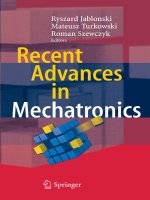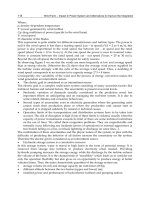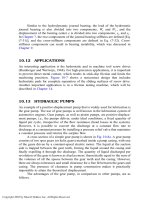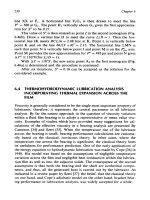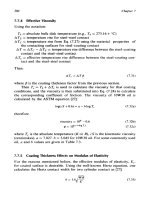Recent Advances in Mechatronics - Ryszard Jabonski et al (Eds) Episode 2 Part 6 doc
Bạn đang xem bản rút gọn của tài liệu. Xem và tải ngay bản đầy đủ của tài liệu tại đây (2.28 MB, 40 trang )
4. Two-parameter pressure and temperature measuring
converter based on piezoresistive sensor
The formulas (1) form a mathematical model of two-variable measuring
converter of pressure and temperature to resistances
R
1
and
R
2
({
p
,
ϑ
}→{R
1
,
R
2
}). By inverting these formulas is possible to determine the
values of pressure and temperature if values of resistances
R
1
and
R
2
are
known. The inverted model has following form:
38.31),(9.256),(7.260
8.361),(29.59),(24.17
21
21
++−=
−
+
=
pRpRp
pRpR
ϑϑ
ϑ
ϑ
ϑ
(2)
In this way a two-parameter (two-dimensional, 2D) converter of sensors
resistances to pressure and temperature ({R
1
, R
2
}→{p,
ϑ
}) may be realized.
It is evident, that a proper conditioning circuit and computation device are
necessary, as it is shown in Fig. 4.
A conditioning circuit, shown in Fig. 5, was applied.
pressure snsor
measured
quantities
Results
p
*
,
ϑ
*
p,
ϑ
conditioning
circuit
computation
device
R
1
R
2
pressure snsor
measured
quantities
Results
p
*
,
ϑ
*
p,
ϑ
conditioning
circuit
computation
device
R
1
R
2
Fig. 4. Structure of measuring chain of two-variable pressure and temperature
converter based on piezoresistive sensor
output signal
time
T
H
T
L
a) b)
CRT
CRRT
2L
21H
2ln
)(2ln
⋅=
+⋅=
output signal
time
T
H
T
L
a) b)
CRT
CRRT
2L
21H
2ln
)(2ln
⋅=
+⋅=
output signal
time
T
H
T
L
a) b)
CRT
CRRT
2L
21H
2ln
)(2ln
⋅=
+⋅=
Fig. 5. Conditioning circuit based on NE555 oscillator (a), pulse output signal (b)
584 H. Urzędniczok
The output signal is a pulse signal and both of the two time intervals T
1
and T
2
depends on resistances R
1
and R
2
and in consequence on measured
values p and
ϑ
.
As a computation device the ATmega8 microcontroller was applied to
measure time intervals T
1
and T
2
and to calculate the measured values p
*
and
ϑ
*
. Equations (2) were used.
5. Conclusions
The above described transducer was calibrated. In Fig. 6 the errors ob-
tained for whole ranges of pressure (0 40 kPa) and temperature (20 90
°C) are plotted.
Fig. 6. Errors of investigated two-parameter transducer
As it is visible, maximum value of this errors not exceed 0.4 °C for tem-
perature and 1.4 kPa for pressure (0.6% and 3.5% in relation to the meas-
uring range respectively). This value was obtained with assumption of
first-order (linear) model of the transducer (1). Applying second-order
model allows errors decreasing, but makes calculation more complicated.
Instead above proposed global models (1) and (2) other method, described
for example in [2], may be considered to determine measured values.
References
[1] R. S. Figliola, D. E. Beasley, “Theory and design for mechanical
measurements”, John Wiley & Sons, New York, 1991.
[2] H. Urz
ę
dniczok, “The Uncertainty of an Algorythmical Reconstruction
Method for the Two-parameter Measuring Converter”, Proceedings of
“XV Sympozjum Modelowanie i Symulacja Systemów Pomi-
arowych”, Krynica, 2005, (in polish).
585Two-variable pressure and temperature measuring converter based on
Modelling the influence of temperature on the
magnetic characteristics of Fe
40
Ni
38
Mo
4
B
18
amorphous alloy for magnetoelastic sensors
R. Szewczyk
Institute of Metrology and Measuring Systems, Warsaw University
of Technology, ul. św. A. Boboli 8, 02-525 Warszawa, Poland,
tel.: +48-22-234-8519, e-mail:
Abstract
This paper presents results of the modelling of the influence of temperature
on the magnetic characteristics of Fe
40
Ni
38
Mo
4
B
18
amorphous alloy in as
quenched state. For modelling Jiles-Athertos-Sablik model was used. Evo-
lutionary strategies together with Hook-Jevies optimization were applied
for calculation of model's parameters on the base of experimental results.
To provide sufficient (from technical point of view) agreement between
model and experimental data, the extension of Jiles-Athertos-Sablik
model was proposed. This extension connect model's parameter k, describ-
ing magnetic wall density, with magnetic state of the material. Good
agreement between experimental data and modelling confirms, that ex-
tended Jiles-Atherton-Sablik model creates the possibility of modelling of
thermo-magnetic characteristics of cores of magnetoelastic sensors.
1. Introduction
Soft magnetic materials such as amorphous alloys are commonly used as a
cores of the mechatronic inductive components such as cores of magnetoe-
lastic sensors or transformers as well as inductive elements of switching
mode power supplies [1]. It should be indicated, that magnetic characteris-
tics of amorphous alloys depends significantly on temperature. This phe-
nomenon has significant technical consequences. Functional properties of
inductive component with soft magnetic material core may change during
586 R. Szewczyk
its operation, especially if it is heated. It may cause malfunction or damage
of mechatronic device.
For this reason knowledge about the influence of temperature of magnetic
characteristics of amorphous alloys is very important from practical point
of view. On the other hand complete model describing of temperature de-
pendences of inductive components was still not presented.
Among four main models of magnetization process [2] only Jiles-
Atherton-Sablik (J-A-S) model gives some possibility of modelling the
temperature dependences of magnetic characteristics. Unfortunately, origi-
nal J-A-S model do not create possibility of modelling the different mag-
netic hysteresis loops of the same material, with one set of model’s pa-
rameters [3]. This is significant barrier in practical application of the mod-
elling of the magnetic characteristics. Presented extension of the J-A-S
model gives possibility of overcoming of this barrier.
2. Extension of the model
Total magnetization M of the soft magnetic material may be presented as
the sum of reversible magnetization M
rev
and irreversible magnetization
M
irr
[4]. In the J-A-S model the irreversible magnetization M
irr
is given by
the equation (1) [5]:
k
MM
dH
dM
irran
M
irr
⋅
−
=
δ
δ
(1)
where parameter
δ
describes the sign of
dt
dH
and k quantifies average en-
ergy required to break pining site. Parameter
δ
M
guarantees the avoidance
of unphysical stages of the J-A-S model for minor loops, in which incre-
mental susceptibility becomes negative [6]. Other parameters of J-A-S
model, such as a, c,
α
, M
s
, t and K
an
are closely connected with physical
properties of the material [4]. As a result J-A-S model can be used for
physical analyses of the magnetization process.
It was indicated [4] that the J-A-S model parameter k changes during the
magnetization process, due to change of the average energy required to
break pining site [7]. On the other hand, previously presented extension of
the J-A-S model [3], where the J-A-S model parameters change in the
function of magnetizing field H, seems unjustified from the physical point
of view. Parameter k should be connected with magnetic state of the mate-
rial (described by magnetization M), not with magnetizing field H [8].
587 Modelling the inuence of temperature on the magnetic characteristics of
To overcome original J-A-S model limitation it should be extended by in-
corporation of connection between magnetic state of the material (de-
scribet by its magnetization M) and model’s parameter k. Parameter k can
be described by the vector of 3 parameters k
0
, k
1
and k
2
, and k is given as
[8]:
)(
1
1
01
Ms) / |M|(1-k
0
2
2
kk
e
e
kk
k
−⋅
−
−
+=
⋅
(2)
In the dependence given by equation (2), parameter k
0
determines the mini-
mal value of k, parameter k
1
determines maximal value of k and k
2
is shape
parameter.
4. Results
Experimental measurements were carried out on the ring-shaped sample
made of Fe
40
Ni
38
Mo
4
B
18
amorphous alloy in as-quenched state. Stable tem-
perature was achieved by criostat, whereas magnetic hysteresis loops were
measured by hysteresisgraph HBPL. Parameters of J-A-S model were de-
termined during the optimization process. For optimization, the evolution-
ary strategies [9] together with Hook-Jevis gradient optimization were ap-
plied .
In figure 1 the experimental results (marked as dots) together with results
of the modelling (marked as solid lines) are presented. One set of J-A-S
model’s parameters was determined for three different hysteresis loops
measured in given temperature. Dependence of the J-A-S model parame-
ters on temperature is presented in Table 1.
Results presented in figure 1 shows very good agreement between ex-
tended J-A-S model and experimental results. To confirm this agreement
r
2
coefficient was calculated between model and experimental results. Due
to the fact, that r
2
is higher than 0.99, it was indicated that 99% of total
variation of experimental results is described by the extended J-A-S model
[10].
It should be indicated, that one set of parameters enable modelling of dif-
ferent hysteresis loop at given temperature. If temperature changes, new
set of parameters should be calculated. On the other hand, on the base of
table 1, temperature dependence of J-A-S parameters can be interpolated
for different temperatures from 20
o
C up to 120
o
C, as well as extrapolated
for higher or lower temperatures.
588 R. Szewczyk
-0.1
-0.08
-0.06
-0.04
-0.02
0
0.02
0.04
0.06
0.08
0.1
-6 -4 -2 0 2 4
6
T = 120
o
C
20
o
C
H (A/m)
B (T)
Fe
40
Ni
38
Mo
4
B
18
as-quenched
a)
-0.2
-0.1
0
0.1
0.2
-10 -5 0 5
10
T = 120
o
C
20
o
C
H (A/m)
B (T)
Fe
40
Ni
38
Mo
4
B
18
as-quenched
b)
-0.3
-0.2
-0.1
0
0.1
0.2
0.3
-40 -20 0 20
40
T = 120
o
C
20
o
C
H (A/m)
B (T)
Fe
40
Ni
38
Mo
4
B
18
as-quenched
c)
Fig. 1. Results of the modelling the influence of temperature on the shape
of hysteresis loop achieved for one set of parameters of extended J-A-S model for
magnetizing field Hm (♦ experimental results, results of the modelling):
a) 5 A/m, b) 10 A/m, c)35 A/m
589 Modelling the inuence of temperature on the magnetic characteristics of
Table 1. Results of the modelling temperature dependence of magnetic character-
istics according to extended Jiles-Atherton-Sablik model.
a k
0
k
1
k
2
c
M
s
⋅
⋅⋅
⋅ 10
-5
α
α α
α ⋅
⋅⋅
⋅
10
4
K
an
t
Temp. (
o
C)
A/m A/m A/m A/m J/m
3
20
112.7 467.6 11.12 -8.26 0.466 2.97 2.39 547 0.80
40
97.3 387.5 11.46 -8.66 0.469 3.11 1.93 1 522 0.80
60
93.6 454.4 11.95 -8.97 0.494 3.20 1.83 1 769 0.80
80
92.1 830.6 11.63 -9.18 0.501 3.23 1.78 1 812 0.80
100
90.3 1238.5 11.35 -9.22 0.506 3.21 1.77 1 731 0.80
120
85.5 1905.4 9.69 -11.1 0.480 3.03 1.75 813 0.80
5. Conclusion
One set of parameters of extended J-A-S model enables modelling of the
hysteresis loops of amorphous alloys for different value of maximal mag-
netizing field. In such a case over 99% of total variation of experimental
results is described by the extended J-A-S model.
Presented temperature dependences of J-A-S model parameters enables
modelling of magnetic hysteresis loops for temperatures from 20
o
C up to
120
o
C. Such model may be very useful for determining the temperature
dependence correction factors for magnetoelastic sensors or magnetic sen-
sors (e.g. such as fluxgates) .
Calculations for the modelling were made in Interdisciplinary Centre for
Mathematical and Computational Modelling of Warsaw University, within
grant G31-3.
References
[1] R. O’Handley “Modern magnetic materials” Wiley, 2000.
[2] F. Liorzou et al., IEEE Trans. Magn. 36 (2000) 418.
[3] D. Lederer et al., IEEE Trans. Magn. 35 (1999) 1211.
[4] D. C. Jiles, D. Atherton, J. Magn. Magn. Mater 61 (1986) 48.
[5] D. C. Jiles, D. Atherton, J. Appl. Phys. 55 (1984) 2115.
[6] J. Deane, IEEE Trans. Magn. 30 (1994) 2795.
[7] P. Gaunt, IEEE Trans. Magn. 19 (1983) 2030.
[8] R. Szewczyk, J. Phys D. (2007), in printing.
[9] H. P. Schwefel “Evolution and optimum seeking” Wiley 1995.
[10] M.Dobosz M. „Wspomagana komputerowo statystyczna analiza wynikow
badan” EXIT, Warszawa 2001.
590 R. Szewczyk
“Soft particles” scattering theory applied to the
experiment with Kàrmàn vortex
J. Baszak, Prof. Dr. R. Jablonski
Warsaw University of Technology, Faculty of Mechatronics, 8 Boboli Str.
Warsaw, 02-525, Poland
Abstract
The paper presents consideration of light scattering on Kàrmàn vortex
street phenomenon [1, 2]. The analytical approximation of the scattering is
provided. It is based on a method using expansion into spatial spectrum
Kotelnikov-Shannon sampling functions [3]. The final result is referred to
the data acquired from gaseous flow installation.
The method described herein is applied to count a number of vortices
appearing behind a bluff body. The best signal to noise ratio (SNR) is
searched at the angular scattering characteristic.
1. Introduction
There is no single and fruitful theory of scattering but plenty of different
approaches, like Rayleigh or Mie theory, which solve partially some
particular problems but do not explain physical mechanism entirely [4].
Existing methods of approximation solution like anomalous diffraction
(AD, by van de Hulst), T-matrices, DDA are complex and time consuming
[5]. However AD approximation is very popular since it gives very good
estimation for medium size particles.
In this paper the approach recently developed and described in [6] is put
into practice to specific application. It allows separating process of
intrinsic scattering from diffraction process (in its immediate sense).
Accordingly, both processes are also considered independently and their
analytical descriptions are conducted separately. It significantly reduces
the complexity of final, numerical calculations but still preserves
acceptable level of accuracy.
The entire calculation is applied to coherent, linearly polarized light
scattered on water droplets floating injected into air flow in a pipe. The
droplets are distributed in space by Kàrmàn vortices generated by bluff
body. The experimental verification of this theory proves the correctness
of the applied analytical method.
2. Analytical calculation
The particle-light interaction is split in two processes. The scattering
restrictively is considered as secondary radiation of the light from
enlightened particle. It means the part of incident radiation hits the particle,
then is absorbed and afterward re-radiated out from the particle. The
remaining part of the incident radiation takes part in diffraction. In this
sense the total scattering intensity (in its wider meaning) can be expressed
as simple summation of scattered and diffracted light intensity. For
simplicity only electric part of radiation is taken into account.
The diffracted field is expressed by Kirchhoff integral in Fraunhofer zone.
The scattered field can be expressed without complicated integration as
follow: E
scatt
=
∇
×
∇
×Π
e
, under assumption of lack of Π
m
(magnetic Hertz
vector) and electric and magnetic currents as well. Consequently, for
monochromatic wave with linear polarization in frequency domain E
scatt
is
linear function of Π
e
with a certain scaling factor adjusting them into same
coordinates. And in Fraunhofer zone both vectors can be considered as
parallel. Next, the Hertz vector can be derived from electric polarization p
of the particle. Referencing briefly to [3] it is easier to consider
polarization p in its spatial spectrum expansion based on Kotelnikov-
Shannon sampling functions.
Then, there is no complicated interference among infinite amount of field
vectors (coming from point vectors of elementary volume of the particle)
with promptly alternating phase. Hence there is no interaction of
components and simple summation can be executed.
Under assumption of dilute non-polar isotropic gases the linear and local
relation between polarization p and incident electric field amplitude is
simple: p (r) = α · E
in
(r), where α is a tensor of polarizability in general
and r is spatial variable.
After additional several transformations the final equation for the
scattering component of intensity from a single, spherical particle and at
unity input power is following:
(1)
( )
( )
mf
m
m
mE
scatt
,,
2
1
2
1
,,
24
2
2
2
2
1_
θρρ
π
θρ
⋅
⋅
⋅
+
−
=
592 J. Baszak, R. Jabłoński
where
The parameter ρ=4·π·a/λ where a– characteristic size of the particle and λ
is incident light wavelength, θ is the angle of scattering, m denotes relative
refraction index (=n
1
/n
2
) which for water drops in the air is approximately
equal to 1.3. The final equation for the diffracted component of intensity
from the single, spherical particle and at unity input power is as follow:
(2)
where T filters are expressed by the equations:
The intensity calculation was done for population of particles with
symmetrical Gaussian distribution (2.3, 1.0) assumed, where 2.3m is the
average value of a droplet diameter and 1.0m is its variation (1·σ).
3. Experimental result and data comparison
The experimental setup is presented in Fig. 1 [1, 2]. The collimated laser
beam from 650nm laser diode was forward scattered at water aerosol
floating in an air discharge in a pipe.
Two series of measurements are scaled along ordinate and compared with
calculated value (Fig.2). The data depicted air1 and air2 are related to
discharge in range Re=7000÷15000. The calculated value at each point is
integrated over the aperture of the collecting optics.
( )
( )( )
( )
( )( )
( )
( )
( )
( )
( )
22
2
2
1
2
sin2,,
,,
sin
arcsin,,
,,
1
,,cos
,,
,,sin
3,,
−
+⋅
⋅⋅=⋅
=⋅
⋅
⋅
⋅−
⋅
⋅
⋅=
m
mmB
mB
mB
mB
mB
mB
mB
mf
θ
ρθρρ
θρ
θ
θρθ
θρρ
θρρ
θρρ
θρρ
θρ
( )
(
)
(
)
2
1
2
1_
sin
,sin
,
⋅
⋅⋅
=
θπ
θρθρ
θρ
TJ
E
diff
(
)
(
)
(
)
( )
( )
( )
6
2
2
2
1
21
3
exp,
3
exp
1
3
exp
,
π
θ
θ
ρ
ρ
ρ
θρθρ
⋅−
=
−
=
⋅=
TT
TTT
593“So particles” scattering theory applied to the experiment with Kàrmàn vortex
Fig. 1. Scheme of experimental setup
Each indicatrix is very asymmetric rather like in Mie theory. The widely-
known multi-lobes shape of the diffraction indicatrix has changed in case
of Gaussian distribution of the particles into soft, one lobe plot. This is
similar to an envelope of diffraction of medium size particles, which
conforms to both: assumed distribution and the aerosol parameters. The
existing local and mild humps remain sharp lobes of interference at single
particle diffraction plot. All plots are parallel to line with the slope of -1/5.
Fig. 2. Analytical and experimental indicatrices
The impact of the diffracted field on the total field is negligible. It has
share of less then 7% at angle θ =7° and goes below 1% at 18°.
Fig. 3 shows the indicatrix and SNR plot for the same data. SNR is
calculated from the Fourier spectrum of the signal (intensity oscillation
Light Source, LD
Input O
ptics
Pipe
Bluff Body
Out
put Optic
s
Discharge
x
1
θ
θθ
θ
Detector
1
10
100
5 10 15 20 25 30 35 40
theta [deg]
E_total [a.u.]
air1
air2
calculated
594 J. Baszak, R. Jabłoński
along Kàrmàn street). The Kàrmàn vortices were generated by bluff body
immersed in the flow in countercurrent and torn away modulating the
scattered field. The intensity is about 7 times lower at angles bigger then
20° compared to almost forward scattered one.
However SNR has its maximum at the angle 20° (roughly). Usually the
less light the more significant share (if expressed by coefficient of
Fig. 3. Indicatrices and SNR in the air
variation) of photon shot noise. The presented phenomenon gives the idea
of additional asymmetry of observed scattered field where at certain angles
the intensity contains less noise.
4. Conclusion
The research indicated the strong relationship between the light noise level
and the vortex geometry was expected. This idea needs to be further
investigated.
5. References
[1] J. Baszak, R. Jablonski, Jour. of Phys. 13 (2005) 86
[2] J. Baszak, R. Jablonski, Optoel. Instrum. & D. Process. 40, 5 (2004) 12
[3] V. M. Rysakov, Jour. of Quant. Spectr. & Rad. Trans. 87 (2004) 261
[4] G. H. Meeten, Opt. Comm 134 (1997) 233
[5] P. Nitz et al., Solar En. Mat. & Solar Cells 54 (1998) 297
[6] V. M. Rysakov, Jour. of Quant. Spectr. & Rad. Trans. 98 (2006) 85
0
10
20
30
40
50
60
70
80
10 15 20 25 30 35
theta [deg]
E_total [a.u.]
0
2
4
6
8
10
SNR [a.u.]
calculated
air1
S/N, air1
595“So particles” scattering theory applied to the experiment with Kàrmàn vortex
1
Measurement of cylinder diameter by laser
scanning
R. Jabłoński*(a), J. Mąkowski(a)
(a) Warsaw University of Technology, Institute of Metrology and
Measurement Systems, ul. św. A. Boboli 8, Warsaw, 02-525, Poland
Abstract
The existing diffraction theories do not fit to engineering applications
because they do not concern the phenomena on 3D bodies. When using
Fresnel theory for volumetric obstacles, the corrections depending on the
shape of obstacle have to be taken into account. We proved experimentally
the hypothesis that the distance between two parallel edges of curved
surfaces depends on the curvatures of these edges. For instance, when
measuring the diameter of cylindrical object the appropriate correction
dependent on the size of object must be taken into account. The experiments
were performed with cylinders 1.1mm, 2.8mm and 4.8mm - used as
reference standards
.
1. Introduction
In laser measuring scanners the measurement information is transformed
several times and finally the detector output signal has the form of shadow of
an object. Its ideal trapezoidal shape is distorted due to the dynamic changes of
signal components (diffracted, reflected and geometrical beam) especially
when object size is much bigger than beam waist diameter.
In previous papers [1,2,3], two the most important errors concerning laser
measuring scanners were pointed out: instability of rotational velocity of
deflector and output signal errors. The problem of instability of rotational
velocity can be solved by direct angular measurement of deflector. This
procedure was described in [1]. The output signal errors were firstly partially
analyzed in [2,3]. But still there are several questions left without answer,
like for instance:
- what is the minimum required area of intensity distribution pattern
to be measured by photodetector (in order to obtain the measurement
on satisfactotu uncertainty level).
- what are the upper and lower limits for the diameter of the
cylindrical object to be measured,
- what in the influence of object surface finish.
2
Recently we designed a modified version of laser measuring scanner for
measurement accomplished in our institute - designed to measure the cross-
section of bars of various shape. When measuring the radii of oval bars, it
was discovered that the measured dimension depends on the curvature. The
results were confirmed by classical contact method using laser
interferometer. We made a hypothesis, that the distance between two parallel
edges of curved surfaces depends on the curvatures of these edges.
Following that hypothesis, we assumed that the accurate measurement of a
diameter of cylindrical object requires the correction dependent on the size
of object.
2. Theoretical considerations
The present applications of diffraction theory in metrology are fragmentary
and may be concluded that the existing solutions for diffraction of 3D bodies
do not fit to engineering applications.
The Fresnel diffraction theory [4] concerns the light diffraction phenomenon
on the straight edge of half-plane. The edge of cylindrical object is straight,
but it can be treated as sharp only when boundary condition is fulfilled
(radius of curvature = 0).
In Kirchhoff’s theory there are no limits concerning the shape or thickness of
obstruction. The influencing quantity is only the edge of obstruction.
Following the above considerations[4] and dealing with vector potential for
compound phase and amplitude structure, the arbitrary wave field can be
presented as a superposition of plane waves. Since such possibility exists also
for Gaussian beam, it can be assumed that diffraction on cylindrical object is
described as a decomposition of a spatial distribution of light into a series of
plane waves.
The distinct maxima (corresponding to diffraction fringes of Fraunhofer
diffraction pattern laboriously obtained from Cornu spiral, Fig.1) are easily
obtained in our experiments.
Fig.1. Cornu spiral and Fraunhofer diffraction pattern
597Measurement of cylinder diameter by laser scanning
3
The paper concerns the experimental method of defining the approximation
errors of applying Fresnel theory to the cylindrical objects. Having the above
in view, the close analysis of detector signal was carried out.
3. Experimental set-up
The experimental set-up is shown in Fig.2. An object O, polished steel
cylinder, is placed at the focal distance of scan lens SL. He-Ne laser with
beam expander and scan lens SL create the laser head LH. Scan lens, of the
focal length 48mm, forms the beam waist 2w
0
=47µm along the Z axis.
Fig.2. Measuring set-up
In order to avoid the inaccuracies caused by the instabilities of angular
deflection, the entire laser head is scanned across the Z-axis, by drive XD (X
linear scanning). The sensor S .is used to control straightness of laser head
movement. The detector unit (set coaxially with laser beam axis) is
composed of photodiode D, aperture 0.3mm A and electronic circuit. It was
calibrated with the power meter (LaserMate-Q, Coherent) and obtained
signal (in V) is proportional to the measured light intensity. Computer
controls scanning movement and is used to process the obtained data.
Fig. 1 does not show many auxiliary components like: system assuring
parallel laser travel, vibration protection set-up, dark chamber, detector
electronics, etc.
4. Measurements
The measurement begins with the laser beam axes placed far behind the
object edge (in this position detector records the minimum signal). During
scanning, the laser beam gradually approaches the edge of object and the
diffraction wave appears and interferes with geometrical wave [3]. In
accordance to Fresnel theory interference fringes appear and the first order
fringe approaches the detector. Then the registered intensity slowly
598 R. Jabłoński, J. Mąkowski
4
decreases and reaches (theoretically) zero value (it corresponds to the central
position of laser head, when the laser beam is obstructed by object). After
passing the object detector registers the signal on the others side of an object
(and again first order, distinct interference fringe is registered).
In this experiment, the laser head is scanned parallel to beam axes and
intensity distribution pattern is collected by the stationary detector.
Laser head is scanned in 2,5µm steps. At each detector position 500
measurements are recorded with the rate 1000Hz. Only the middle part of
measurements (between 250-400 is taken for further processing).
An advance data acquisition system (and computer program) was
accomplished. This system realizes the following functions:
1. reading the required measurement data
2. determinates the maxima on both sides of an object
3. calculates the distance between maxima
4. takes into account the correction coefficient and calculates of the
corrected dimension
5. drawing (in optional magnification) the result
5. Results
Fig.3 shows an exemplary result obtained by scanning cylinder of diameter
1.1mm.
Fig.3. Exemplary cylinder diameter measurement
599Measurement of cylinder diameter by laser scanning
5
The upper right graphs (and data) present a close look at the left and right
maximum. The difference in amplitudes gives evidence to non-coaxial
setting of object and detector in reference to laser beam axes. This has no
influence on result, but can be used for future adjustments.
The experiments were performed with cylinders 1.1mm, 2.8mm and 4.8mm
- used as reference standards (uncertainty 1µm). In Tab.1 and Fig.4 the
nominal and experimental values of diameter are presented.
Fig.4. Cylinder diameter corrections
6. Summary
We proved the hypothesis, that the distance between two parallel edges of
curved surfaces depends on the curvatures of these edges. In case of he
accurate measurement of cylindrical objects the correction, dependent on the
size of the object, must be added. We assume that correction function has
sinusoidal shape.
References
[1] Jablonski R.: SPIE vol. 2101, 1993, 741-749
[2] Jablonski R. Key Engineering Materials, Vo.l 295-296, pp.209-214
[3] Jabłoński R. Mąkowski J., Proc. 8th ISMTII, Sendai, Japan, 2007, p.6
[4] Born M., Wolf E. Principles of optics –Pergamon press- 1964
Diame
ter/mm/
Corr
ection
Nominal Experi
mental
m
1,100 1,135 -35
2,800 2,790 10
4,800 4,745 55
600 R. Jabłoński, J. Mąkowski
Tyre global characteristics of motorcycle
F. Pražák (a) *, I. Mazůrek (b)
(a, b) Faculty of Mechanical Engineering, Brno University of Technology
Technická 2, Brno, 616 69, Czech Republic
Abstract
Identity of simulation model is influencing duality of single parameters.
This paper is describing on measurement and evaluation stiffness of tyre
depending on speed of loading, so-called dynamic stiffness tyre. In this
case, we were orient on tyre of sport road motorcycle, where we are at first
watched influence camber of tyre from vertical surface on resulting char-
acteristic. The measuring characteristic we are express as force dependent
to compression and speed of compression, so-called tyre global character-
istic. Mathematical description of global characteristic makes it possible
simply and more accurately creation virtual model of tyre used in the mul-
tibody software.
1. Introduction
In most of mechatronics systems are subsystems and parts, which embody
expressive non-linear behavior. This behavior must be defaced at modeling
and design of these systems. Common non-linear effects are characterized
simply functional dependence, such as saturation or non-sensitivity. Mod-
els of these non-linearity are simple and they are common to disposition in
libraries different simulation systems as is Matlab/Simulink. More compli-
cated non-linear effects are for example sliding friction and hysteresis are
described simple. In several cases need not constitute enough loyal - ade-
quate model of relevant non-linear effect.
In simple mathematic model of vehicle suspension wheel is tyre as linear
spring (fig. 1a), more realistic models reason with non-linear characteris-
tics (fig. 1b). If it is reason with inner damping of tyre, it is most often with
friction damping model. Size of friction force is constant and depends only
on direction of deformation velocity (fig. 1c). Endeavour by supplying of
hysteretic rubber properties with the help friction force (fig. 1d) is largely
distant by real dependence of deformation force on deformation at cyclic
loading of tyre (fig. 1e).
a) b) c) d) e)
Fig. 1: Different tyre characteristic in model of suspension wheel
A vehicle wheel with tyre is not as simple air tyre. To properties of tyre are
shows viscoelastic properties inner tyre structure. Rubber os non-linear
and hyperelastic material, whose mechanical properties are floating with
temperature, but with operating time too. It is necessary know mechanical
properties of tyre. Against this properties, it is possible create computation
model for numeric simulation.
Results of height mentioned, it is necessary
measuring of force in dependence on defor-
mation, but on velocity of deformation too.
In laboratories Brno University of Technol-
ogy, Institute of Mechanical Design, on
slightly modified damper tester, we are iden-
tification viscoelastic parameters of Barum
Bantam tyre with size 12x4 (Fig. 2). The
bantam tyres are characteristic in that they
are changing at compression size of contact
surface to road. Between tyre and road are
generating tangential force. This type of tyre
is using for agricultural engineering, plane
and small motorcycle.
In the first phases, spring and dampening
properties were finding separately, similarly
as with vehicle or motorcycle shock absorber
strut. Stiffness characteristics at very low
velocity of deformation (< 0.005m/s) are different, according to select
stoke they show different hysteresis properties. In figure 3, hysteresis loop
are unloaded in dependence on force-deformation for tested strokes.
0
500
1000
1500
0 10 20 30
deformation [mm]
force [N]
0
500
1000
1500
0 10 20 30
deformation [mm]
force [N]
0
500
1000
1500
0 10 20 30
deformation [mm]
force [N]
0
500
1000
1500
0 10 20 30
deformation [mm]
force [N]
0
500
1000
1500
0 10 20 30
deformation [mm]
force [N]
Fig. 2: Tested tyre in
tester
602 F. Pražák, I. Mazůrek
-500
0
500
1000
1500
2000
2500
3000
-15 -10 -5 0 5 10 15
Deformation [mm]
Deformation force [N]
3.8mm 10.2mm 26.7mm
-400
-300
-200
-100
0
100
200
300
-2.0 -1.5 -1.0 -0.5 0.0 0.5 1.0 1.5 2.0
Velocity of deformation [m/s]
Deformation force [N]
3.8mm 10.2mm 26.7mm
On figure 4 are F-v curves of these variants. Dampening characteristic is
markedly dependent on test stroke and it is impossible use flat dampening
characteristics. It is not proper tyre model as system with one F-s and F-v
characteristics.
2. Globální charakteristika pneuamtiky
Therefore, we decided to solve the problem adequately to global damper
characteristics [1] to measurement so-called global tyre characteristics.
The test of tyre proceed by method start-finish, where in time one minute
we are increase frequency of tyre compression to maximum frequency and
then the frequency was decreasing until to stopping the tester. The test was
made for three different value of compression (4, 10, 26mm) and four dif-
ferent tyre pressure (0.7, 1, 1.5 a 2bar). The assessment of test conditions
was from request step over due nature frequency of suspension wheel
(c. 20Hz).
In figure 4 (for pressure 1.5bar), aftermath of hysteresis tyre behavior are
visible. To describe of mechanical properties, it is possible fenomenologic
access, which is found on mathematic model [2]. Mathematic model is
voiced by the help of deformation energy density and it describes linear
relation between strain and shear deformation. Thereby calculation for
each interactive step would be high overloaden superior model of wheel
suspension, eventually vehicle.
A quick approach seems to be procedure parameterization of regression
analysis real global characteristics with one departure from reality. Before
regression analysis it is eliminated hysteresis loop by numeric. Then, for
superior model is available smooth 3D function, which it is providing val-
ues of viscoelastic force F in depending on both deformation d and veloc-
ity of deformation v. It is multiple regression function of second-rate:
Fig. 3: Tyre characteristics for three
different compressions
Fig,. 4: Dampening tyre characteris
tics
603Tyre global characteristics of motorcycle
21
2
2
2
121
xfxexdxcxbxay +++++=
(1)
Calculation of response in superior models is fast and enough accurate
with this simple function. In figure 5c is shown expressive wave of regres-
sion surface at high velocity of deformation. It may result in influence at
simulation of over-cross hurdle high velocity. Influence of simplification
will test on quarter car model [3] and next on vehicle.
Fig. 5: Global tyre characteristics for stroke 4,
10 a 26mm
Fig. 6: Surface adventitious by
regression analysis from
global characteristics
604 F. Pražák, I. Mazůrek
3. Conclusion
In our test-room, the new methodic of measurement of viscoelastic tyre
properties was created. Resulting dependence was called as global tyre
characteristic. The method of analysis makes it possible separate hysteretic
properties of tyre from basic deformation characteristic. Identification of
tyre parameters with method proposed regression analysis makes it possi-
ble simple implementation to superior models. Before personal design and
testing of simulation models, it is necessary plan experiments so they pro-
vided all information for identification of needed parameters.
This work was developed with the support of the grant project
GA�R No.: 101/03/0304
References
[1] Votrubec R.: Globální charakteristika tlumi�e, dissertation work, Tech-
nical University of Liberec, Liberec, 2005
[2] Bergstršm, J., S.; Boyce, M., C.: Constitutive modeling of the large
strain time – dependent behavior of elastomers, J. Mech. Phys. Solids.,
Vol. 46, 1998, ISSN 0022-5096
[3] MAZ�REK I, DO�KAL A., Pražák F.: Diagnostic model of a shock
absorber, Engineering Mechanics, 2005, ISSN 1210-2717, str. 71-76
605Tyre global characteristics of motorcycle
Magnetoelastic torque sensors with amorphous
ring core
J. Salach
Institute of Metrology and Measuring Systems
Warsaw University of Technology,
sw. A. Boboli 8,
02-525 Warsaw, Poland
Abstract
This paper presents new type of magnetoelastic torque sensors. In this sen-
sors the amorphous ring cores were applied as sensing elements. The ring
cores were in as-quenched state and after thermal relaxation. For the inves-
tigation three type of tape were used, iron based (Fe
78
B
13
Si
9
), nickel based
(Fe
40
Ni
38
Mo
4
B
18
) and Finemet (Fe
73.5
Si
13.5
Nb
3
Cu
1
B
9
). Sensor investigation
indicate interesting properties and high sensitivity. Results prove that the
thermal relaxation is necessary and select the best compose of ring core.
1. Introduction
Idea of application of amorphous magnetic materials as compressive sen-
sors proved, that these materials exhibit significant influence of stresses on
magnetic properties [1]. Moreover such alloys have very high stress
strength together with rust resistance [2]. For these reasons it seems, that
amorphous magnetic alloys are the best known material for magnetoelastic
sensors applications.
On the other hand industrial application of the amorphous magnetic alloys
for torque measurements seems to be still not possible from engineering
point of view. The main barrier in development of torque sensors made of
metallic glasses is connected with the lack of the method of applying an
uniform, torque moment to magnetoelastic sensing element with closed
magnetic circuit. The problem is additionally complicated due to the fact,
that amorphous magnetic materials are produced in the form of thin rib-
bons with thickness less than 25 µm [3]. This paper presents ideas of over-
coming these problems.
Fig. 1. Device for application of the torque to magnetoelastic ring-shaped core [4]:
1 – magnetoelastic sensing core, 2 – non-magnetic backings with grooves
for winding, 3 – magnetizing and sensing windings
Fig. 2. Magnetoelastic sensor in single-coil configuration:
GU – Voltage Generator, R – resistor, V – voltmeter
Fig. 3. Magnetoelastic sensor in transformer configuration:
GU – Voltage Generator, R – resistor, V – voltmeter
607Magnetoelastic torque sensors with amorphous ring core
2. Method of investigation
New methodology of application of the torque to the ring shaped core is
based on the idea of application of the torque moment T
s
in parallel direc-
tion to the direction of the axis of the ring [4]. As a result uniform distribu-
tion of the shear stresses
τ
can be achieved. This uniform distribution of
stresses (non-uniformity is less than 5%) was confirmed during the ther-
movision tests [5].
Device for practical utilization of developed method of application of the
torque is presented in figure 1. The magnetoelastic ring-shaped sensing
core (1) is mounted to the base planes of the special nonmagnetic backings
(2). Due to these grooves the core can be winded by magnetizing and sens-
ing winding (3) and the changes of sensing element’s parameters under
influence of torque T
s
can be measured. These backings are similar to pre-
sented previously backings for application of the uniform compressive
stress to the ring core [6].
For development of magnetoelastic torque sensors two configuration of
electronic transducer were proposed: single-coil configuration and trans-
former configuration. In single coil configuration changes of the imped-
ance of amorphous alloy based inductive element result in changes of the
value of current in the circuit. This current is measured on resistor R with 1
ohm resistance, whereas it is supplied from the sine-wave voltage genera-
tor GU with given maximal voltage. In the transformer configuration pri-
mary winding is supplied from sine-wave current source GI with given
value of maximal current. Output signal is generated by the secondary
winding of the transformer.
In both cases the TrueRMS value of output signal were measured by spe-
cialized multimeter. It should be indicated, that TrueRMS value of output
voltage is much more robust on clutter than for example peak-to-peak am-
plitude. For this reason measurements of TrueRMS signal increase accu-
racy and repeatability of magnetoelastic torque sensors.
3. Results
In figure 4 the influence of torque Ts on the magnetic characteristics is
presented. Under the torque up to 4 Nm shape of hysteresis loop of
Fe
40
Ni
38
Mo
4
B
18
amorphous alloy annealed in 380
o
C for 1 hour changes
significantly. As it is presented in figure 4a the value of both remanence B
r
and maximal flux density decreases whereas coercive force H
c
is nearly
constant. The influence of torque T
s
on the value of the maximal flux den-
608 J. Salach
